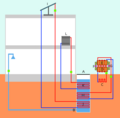Heat_pump_system_on_rainwater_pit.png (442 × 436 pixels, file size: 6 KB, MIME type: image/png)
This file is from Wikimedia Commons and may be used by other projects. The description on its file description page there is shown below.
Summary
| DescriptionHeat pump system on rainwater pit.png |
English: Schematic of a heat pump system that uses a rainwater pit as a heat sink. The rainwater can be used at the house for showering (as indicated here), washing hands, flushing the flush toilets (if present), ... Note that the rainwater is herefore connected to the cold water tap of the fossets. This is also why the pipe is connected so low in the rainwater pit.
The heat pump shown here is a ground-source heat pump (ground/water-source heat pump to be exact as it transfers his heat to water which is used in the radiators in the house). [1][2]The heat pump shown has it's heat exchanger dug very shallowly into the soil (1,5m or so). This reduces groundwork, and also makes sense for using it with a rainwater pit (to act as a buffer) as the heat of soil flutuates greatly at this shallow depth in temperate countries, depending on the season. Note that an air-source heat pump (air/water-source heat pump to be exact) can also be used in this setup but is only efficient in countries where it warms up greatly during the day but where it is cool at night, during the entire year. The heat pump would in both cases be fitted with a printed circuit board (PCB) connected to a temperature sensor. The sensor would continuously monitor the temperature of the ground (in the first case) or the air (in the latter case) and if this temperature is high enough, activate the circulation pumps and compressor. If the temperature is too low, it will make sure the circulation pumps and compressor are deactivated. The solar thermal collector indicated is not essential yet helps to warm up the rainwater pit.
References:
|
| Date | |
| Source | Own work |
| Author | Genetics4good |
Licensing
- You are free:
- to share – to copy, distribute and transmit the work
- to remix – to adapt the work
- Under the following conditions:
- attribution – You must give appropriate credit, provide a link to the license, and indicate if changes were made. You may do so in any reasonable manner, but not in any way that suggests the licensor endorses you or your use.
- share alike – If you remix, transform, or build upon the material, you must distribute your contributions under the same or compatible license as the original.
Captions
Items portrayed in this file
depicts
some value
29 April 2013
File history
Click on a date/time to view the file as it appeared at that time.
| Date/Time | Thumbnail | Dimensions | User | Comment | |
|---|---|---|---|---|---|
| current | 12:04, 29 April 2013 |  | 442 × 436 (6 KB) | wikimediacommons>Genetics4good | User created page with UploadWizard |
File usage
There are no pages that use this file.
